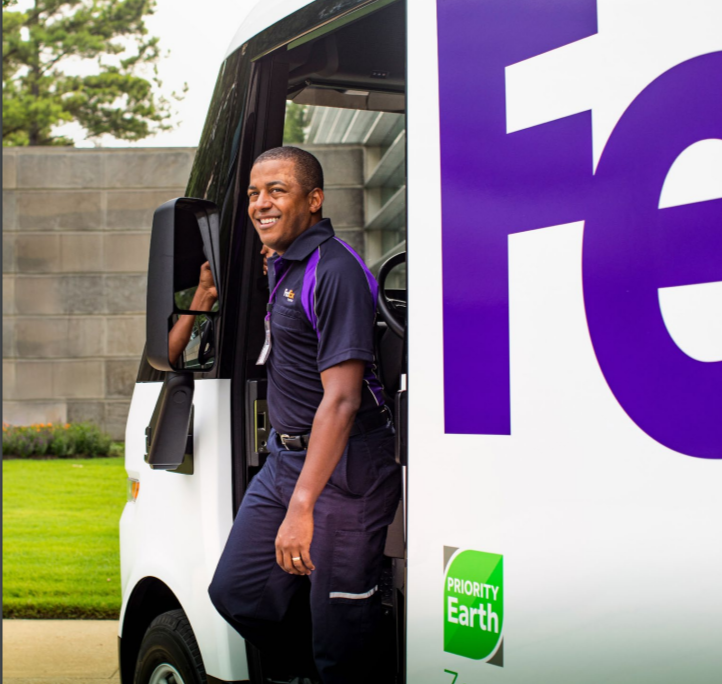Vehicle Electrification at FedEx
Originally published in FedEx's 2022 ESG Report
Electrifying a large portion of our global fleet of over 200,000 motorized vehicles is a crucial component of our carbon neutral operations goal. Through our phased approach, we are revolutionizing our vehicle fleet by working to transition the entire FedEx parcel PUD fleet to zero emission vehicles by 2040.
In 2021, FedEx Express agreed to acquire 500 electric vehicles from BrightDrop, a new business from General Motors, and in January 2022, we expanded our agreement to acquire 2,000 additional electric vans over the next several years. We are currently working on a plan to add up to 20,000 more, subject to further negotiations and execution of a definitive purchase agreement. Through our relationship with BrightDrop, we have also introduced electric pallets, which, in a pilot, allowed couriers to handle 25% more packages per day when used on routes in a high-density, vertical urban environment.
Additionally, FedEx Office and FedEx Freight are exploring pilot programs to electrify their vehicle fleets, continuing along the path toward carbon neutral operations. FedEx Ground is developing a comprehensive strategy to facilitate the electric vehicle transition for independent service providers and is piloting the necessary infrastructure at our facilities to provide access to third-party charging solutions.
To advance progress towards our electrification goal and enhance our intelligent logistics system, we leverage advanced technology to increase vehicle efficiency. We utilize innovative specialty delivery technologies to work within urban centers, which are increasingly implementing regulations to reduce the number of vehicles or create low-emission zones. Roxo™, the FedEx SameDay Bot®, is an autonomous delivery device designed to help retailers make on-demand same-day and last-mile deliveries to their customers and is approved for use in over a dozen states. We have entered a multi-year collaboration with Nuro to test multi-stop and appointment-based deliveries with autonomous, electric vehicles. Additionally, we announced a f irst-of-its-kind collaboration with Aurora and PACCAR to test autonomous driving technology within FedEx linehaul trucking operations.
In Europe, through our Zero Emission City Deliveries Solutions program, we have deployed 70 solutions to increase mobility options for deliveries in urban centers including electric vehicles and cargo bicycles. In China, FedEx Express is working with Neolix to evaluate the implementation of an autonomous, electric delivery vehicle. Additionally, our growing f leet of electric bikes reduces noise levels and combustion engine exhaust compared to traditional last-mile vehicles. In some international cities, such as London and Toronto, electric bikes are directly replacing our vans.
In addition, we continue to electrify forklifts, airport ground service equipment, and other non-road vehicles across our operating companies. Through our phased approach, we are reducing fuel and maintenance costs and anticipate improving our efficiency even further as new technology develops.
Before our purchased electric vehicles are deployed, we must ensure the necessary vehiclecharging infrastructure and technology is in place at our facilities. Building this infrastructure requires significant time and capital, but the commitment of our team members to our innovative strategy—coupled with our collaboration with power utilities, state and local governments, and regulatory agencies—will help us stay on track to deliver on our broader lowcarbon infrastructure solutions. While our electricity usage will significantly increase due to electric vehicle charging, we are developing strategic approaches to overcome this challenge. Learn more about our roadmap to reduce emissions given our increased electricity demand in the Facilities section of this chapter.
Our vehicle electrification strategy builds upon FedEx Express fuel efficiency improvements achieved by optimizing driving routes and replacing vehicles within our fleet with more efficient models. We are using other approaches to reduce our last-mile emissions and in FY20, we launched the Last Mile Optimization program to deliver certain FedEx Express packages through FedEx Ground. Through FY21, FedEx Express improved vehicle fuel efficiency by 42% from a 2005 baseline and has a goal to achieve a 50% improvement by 2025. Looking forward, we are focusing on enhancing our fleet fuel efficiency and avoiding fuel use through the deployment of electric vehicles.



